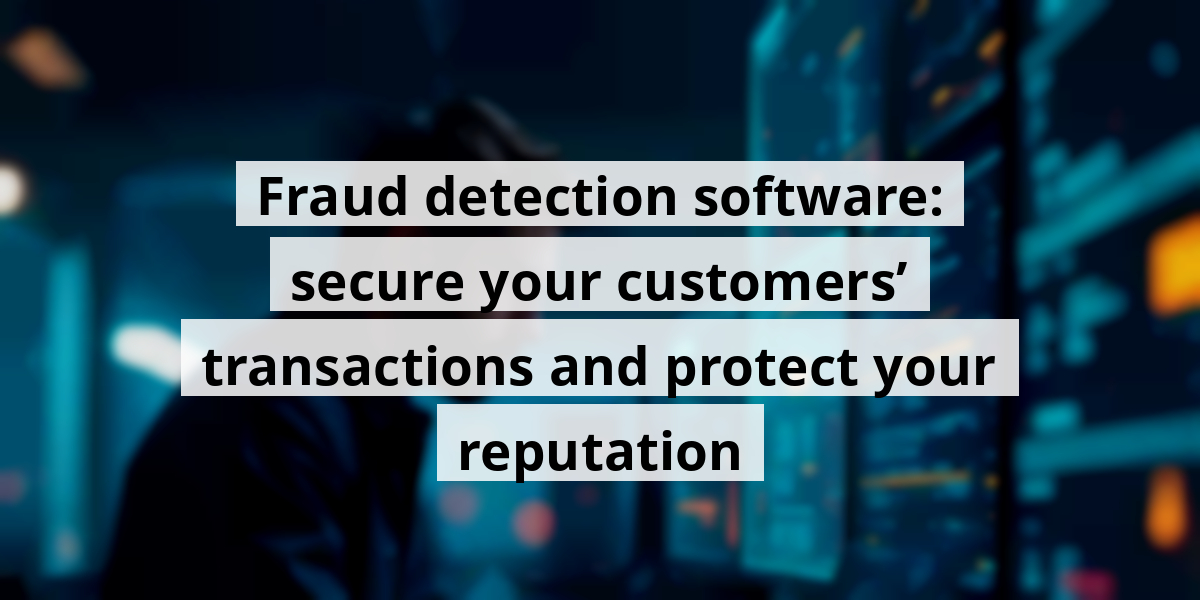
- 29th Aug '25
- KYC Widget
- 18 minutes read
Fraud detection software: secure your customers’ transactions and protect your reputation
Let's face it—fraud is like that uninvited guest that crashes the party and drinks all the good wine. I learned this the hard way when a suspicious transaction popped up on my bank statement. Suddenly, I was knee-deep in research about fraud prevention. From anti-fraud technologies to strategies that make a difference, this wild ride through financial technology has taught me a lot. We've all heard tales of scams that sound too ridiculous to be real, yet they happen every day. So grab a cup of your favorite brew, and let's explore how businesses can stay one step ahead of those pesky fraudsters while keeping their systems intact with a touch of humor and humanity.Key Takeaways
- The rise of financial technology fraud calls for prompt action and smart strategies.
- Custom solutions often outperform generic options in detecting fraud.
- Proven technologies can significantly reduce fraud risks.
- Understanding the shortcomings of anti-fraud software is key.
- Effective fraud detection is essential for long-term business sustainability.
Now we are going to talk about how we keep our finances safe from the sneaky world of fraud. Remember that time when you got a text from a “bank” that had misspellings and a weird link? Yeah, those little scams are everywhere! So, let’s unpack how we can tackle this issue head-on with some clever tools and strategies.
Understanding Fraud Prevention and Anti-Fraud Solutions
Fraud prevention is like a safety net we set up to catch those pesky tricksters before they can steal our hard-earned cash. We’ve all been in a place where we’ve had to adapt quickly to some dodgy requests, right? It's like trying to evade a toddler on a sugar high — they’re everywhere! Whether it’s through software or good ol’ employee training, it’s critical to know what fraud looks like.
Speaking of training, many banks, both the old-fashioned kind and the shiny new neobanks, are getting creative. They're using email campaigns or social media to give us the lowdown on financial scams. It’s almost like they’re our trusty sidekicks, alerting us about the latest cons. Remember the viral meme about the “Nigerian prince”? That’s the kind of thing we need to be aware of — and thanks to these efforts, we are!
Now, let’s chat about anti-fraud software. Think of it like a vigilant security guard who never blinks. This software doesn’t just play guessing games; it uses smart tech to spot potential fraud before it gets far. With features like identifying duplicate entries and flagging transactions that seem a bit fishy, it’s our frontline defense against those who think they can outsmart us.
And did we mention behavioral risk scoring? That’s right! It assesses the likelihood of fraud based on our behavior. It’s like the software knows us better than our best friend who can predict our pizza order. By adopting these solutions, financial companies are bolstering our security and safeguarding our assets. Who doesn’t want that?
Providers of these anti-fraud tools are busy bees. They keep an eye on the latest scams, ready to update their software so it stays sharp. It’s like a game of whack-a-mole; as soon as one fraud scheme pops up, they’re right there to knock it down. Keeping pace with today’s scams is essential — we can’t afford to fall behind.
- Staying informed about emerging scams helps us stay one step ahead.
- Regularly using software updates is crucial for ongoing protection.
- Engaging in training sessions can bolster our defense strategies.
- Identifying unusual behavior swiftly can save us from losses.
So, as we navigate these tricky waters, let’s remember: with the right knowledge and tools, we can certainly keep fraud at bay. And who knows, maybe one day we’ll look back and laugh at that text we almost clicked on!
Now we are going to talk about the latest shenanigans in the FinTech sector regarding fraud trends in 2023. It's a wild ride out there!
Trends in Financial Technology Fraud in 2023
Fraud can pop up like a surprise guest at a party. You never know who it’s going to be — maybe it’s a crafty outsider or, heaven forbid, someone on your own team!
With the rise of tech-savvy criminals, businesses and consumers alike have had to keep their guards up. Remember when we thought online shopping was the future? Now, it's also a playground for fraudsters looking to make a quick buck.
Let’s break down the common types of FinTech fraud that we’re seeing today, categorized by who they are targeting:
- Account Takeovers: Like that surprise party guest, this type sneaks in, taking control of someone else's account. Usually, they do this through phishing attacks or stolen credentials.
- Payment Fraud: This is when someone tries to use stolen card information or fake identities to make purchases. It's akin to trying to pay for dinner with Monopoly money!
- Investment Scams: With everyone looking for the next hot stock, it’s like dangling a shiny object in front of a cat. Ponzi schemes and fake investment opportunities are the bait.
- Ghost Companies: These are fake businesses set up to con people out of their money. Picture a restaurant that exists solely in someone's imagination, taking orders but never serving food.
- Cryptocurrency Fraud: Cryptos are a favorite among fraudsters. Whether it's fake exchanges or misleading investment opportunities, if it sounds too good to be true, it probably is!
As we're cruising through 2023, keeping our eyes peeled for these trends is essential. The FinTech landscape is like a vast ocean; waves of innovation crash alongside the occasional storm of fraud. Just the other day, a friend shared how their bank flagged strange transactions that turned out to be a phishing attempt. It’s a reminder that vigilance is key!
Ultimately, the battle against fraud requires constant awareness and proactive measures. Whether we’re individuals or part of a larger financial organization, every little step counts. Let’s be smart, share our experiences, and keep this fraud at bay! It’s quite a jungle out there. Who knows who’ll come knocking next?
Now we are going to talk about effective ways to keep fraud at bay for FinTech companies while sharing some strategies that work like a charm!
Strategies to Combat Fraud in FinTech: Proven Technologies and Approaches
 We’ve all heard horror stories about unsuspecting friends getting scammed, right? Just last month, a buddy of ours almost fell for a phishing scam that promised him “exclusive access” to the latest cryptocurrency—but all it really served up was a side of regret. That’s why it’s crucial for companies in FinTech to arm themselves with the best solutions out there. When it comes to fraud prevention, creativity meets cutting-edge tech. Let’s explore a few tried-and-true methods that can help keep fraudsters at bay.
We’ve all heard horror stories about unsuspecting friends getting scammed, right? Just last month, a buddy of ours almost fell for a phishing scam that promised him “exclusive access” to the latest cryptocurrency—but all it really served up was a side of regret. That’s why it’s crucial for companies in FinTech to arm themselves with the best solutions out there. When it comes to fraud prevention, creativity meets cutting-edge tech. Let’s explore a few tried-and-true methods that can help keep fraudsters at bay. - Real-time transaction monitoring
- Machine learning models for anomaly detection
- Multi-factor authentication
- Regular security audits
| Strategy | Description | Benefits |
|---|---|---|
| Real-time transaction monitoring | Tracks transactions live for suspicious activity | Immediate alerts, faster response |
| Machine learning models | Detects anomalies using advanced algorithms | High accuracy, reduces false positives |
| Multi-factor authentication | Adds layers of security for account access | Stronger protection against unauthorized access |
| Regular security audits | Evaluates systems for vulnerabilities | Identifies weak spots before they become issues |
Now we are going to talk about the benefits and drawbacks of choosing between off-the-shelf and custom fraud detection solutions. These options can feel like choosing between a store-bought pie and your grandma's secret recipe: both are tasty but have their unique flair!
Canned Solutions vs Tailor-Made Fraud Detection Options
Let’s face it: picking the right fraud detection method can be a bit like choosing a Netflix show on a rainy Sunday—overwhelming and a touch nerve-wracking. First, we should consider what canned solutions bring to the table. These are like the microwave dinners of fraud prevention. They’re convenient, and you can have one ready in minutes, but the flavor? Well, you might miss grandma’s touch. Some benefits of these ready-made solutions include:
- Quick implementation
- Cost-effective options
- Established efficacy (they’ve been at it for a while!)
- Support and updates from the vendor
- A deeper understanding of your business
- Potentially higher costs (think gourmet meal versus fast food)
- Longer implementation times
- Personalized support that’s more in tune with your specific needs
Now we are going to talk about the shortcomings we often overlook with anti-fraud software.
Shortcomings of Anti-Fraud Software
We all love a superhero movie, right? But just like our favorite caped crusaders, anti-fraud software has its flaws. While it’s great at battling crime, we can't ignore some of its kryptonite:
- False positives. Imagine being flagged as a fraudster because you bought your grandmother’s 50th birthday gift two weeks in advance. The software might yell "thief!" instead of saying, "Nice grandkid!" With user habits varying like fashion trends, misjudging someone could tarnish a company’s rep faster than a celebrity scandal.
- False negatives. Sometimes, the software can act like a bad detective in a cheesy movie. Relying on old data might mean fresh fraud patterns slip right under its nose. And let’s be real: fraudsters have more tricks up their sleeves than a magician at a children’s party. They might slide right past our tech with tactics it’s never heard of.
- Incompatibility with legacy systems. Imagine trying to fit a round peg in a square hole. That’s what integrating modern fraud detection software with old legacy systems feels like. It’s like trying to teach your grandparents to use TikTok—lots of confusion, lots of sighs, and a whole lot of “What’s an app?”
- Limited detection capabilities. Some systems might struggle with frauds like identity theft, which is less a game of numbers and more a psychological play. If only they had the Sherlock Holmes skillset—it’s not just about knowing the data, but getting into the mind of the deceitful, which requires a human touch.
- Maintenance and updates. Keeping this software in tip-top shape is like maintaining an antique car. It needs constant care, costs a pretty penny, and can turn into a hassle quicker than you can say “downtime.” Staff retraining? Absolutely. It’s like teaching an old dog new tricks—time-consuming and often met with lingering eye-rolls!
So, while we rely on these digital shields to protect our businesses, it’s crucial we acknowledge these bumps in the road. By understanding these hurdles, we can make more informed decisions, ensuring our defenses are as ready as they can be against the ever-elusive enigma that is digital fraud.
Now we are going to talk about the significance of fraud detection software in today's business landscape. It's like handing a bouncer the keys to your nightclub—essential for keeping the party safe! Trust me, we've all heard those horror stories about businesses getting duped, and let’s just say nobody wants to find out they’ve been scammed over a latte!
Why Fraud Detection Software is Crucial for Businesses
Think about it—every day, companies face an endless parade of sneaky tactics from fraudsters. Fraud detection software isn’t just some luxury item; it's a necessity. We can all relate to that sinking feeling when we realize our hard-earned money is falling into the wrong hands. Here's a reality check: fraud isn't going anywhere, so let’s arm ourselves! When selecting a software solution, we often face a tough choice. Do we go for the quick fix found on a popular software website or invest in something custom? Let’s be real: off-the-shelf solutions can be tempting. They promise to be user-friendly and ready to go—kinda like those one-size-fits-all shirts that shrink after one wash. But do they really fit our unique needs? Not so much. Custom fraud detection software, on the other hand, offers a tailored approach. Imagine having a suit made just for you versus picking one that might fit ‘okay.’ We deserve to have our businesses and data protected in ways that matter to us. Custom solutions can evolve as our businesses grow. They can adapt with our ever-changing needs, giving us a sense of control. And let's face it, the confidence of knowing we have a fortress protecting our finances? That's a game-changer. Some crucial benefits of using fraud detection software include:- Increased Accuracy: Spotting fraud before it strikes.
- Cost Efficiency: Avoiding losses translates to better profitability.
- Scalability: It grows with us, like that loyal pet that doesn’t outgrow your house.
Now we are going to talk about why every FinTech company should seriously consider investing in anti-fraud solutions. Trust us, it’s a topic worth diving into because, let’s be real, no one wants a nasty financial surprise lurking around the corner!
Why Your FinTech Business Needs Protection Against Fraud

Why does a FinTech company require an anti-fraud solution?
In financial services, the stakes can be sky-high. Companies absolutely need anti-fraud software to shield themselves from hefty financial losses, damaging reputations, and those pesky legal troubles. With scams popping up like weeds in springtime, it’s vital to have a sturdy defense. Imagine this: one day, everything's fine, and the next, your funds are disappearing faster than snacks at a movie night! Effective fraud detection and prevention solutions are essential. Thanks to smart tools, teams can suss out suspicious transactions, analyze patterns like a detective on a mission, and ensure that internal controls are as tight as Grandma's hug. Today’s software often couples artificial intelligence with machine learning to offer real-time protection. Think of it as a superhero swooping in to save the day and minimize financial crime risk.
What tech do we employ in fraud protection solutions?
We know that technology is not one-size-fits-all, especially in this field. So, when developing fraud protection software, we carefully tailor our approach based on our clients' unique situations—kind of like hosting a tailored dinner party! Our toolkit includes advanced tools such as AI, machine learning, and predictive analytics. You’d be surprised how these tech wonders weave together. They're particularly critical for larger organizations that need dependable detection methods. And just like a good tailor, we also customize protection mechanisms based on specific business needs—think bespoke suits instead of off-the-rack.
How experienced are we in crafting anti-fraud software?
Our experience in the FinTech sector spans over seven years. During that time, we’ve helped everyone from traditional banks to sprightly neobanks. We’ve developed solutions for wealth management platforms and stock operations. It’s a bit like being a multi-passionate chef—cooking up anti-fraud systems for diverse dishes! Each ingredient needs to be in harmony to avoid financial loss and secure customer transactions. Our expertise includes holistic anti-fraud systems and innovative rule-based algorithms tailored to meet our clients’ needs. It's not just about prevention; it's about cooking up a whole strategy that leaves fraudsters out in the cold.
| Topic | Details |
|---|---|
| Need for Anti-Fraud Solutions | Protection from losses, reputation management, and legal issues. |
| Technologies Used | AI, machine learning, predictive analytics, and tailored custom solutions. |
| Experience in Development | Seven years in the FinTech sector, crafting solutions for diverse clients. |
Conclusion
In a nutshell, protecting your fintech business from fraud is a bit like wearing a seatbelt—it might feel unnecessary until that sudden stop hits you hard. The innovations in this area offer a mix of hope and practicality, and whether you favor slick tools or custom solutions, there’s something for everyone. Balancing budget and security feels like finding the perfect pizza topping combo—everyone has their preferences, but you still want it to taste good in the end. Let's keep our businesses safe and our laughter intact!FAQ
- What is fraud prevention? Fraud prevention acts as a safety net to catch fraudsters before they can steal from us.
- How are banks educating consumers about financial scams? Banks are using email campaigns and social media to alert consumers about the latest scams and fraud techniques.
- What is anti-fraud software? Anti-fraud software serves as a security guard for transactions, spotting potential fraud using advanced technology.
- What is behavioral risk scoring? Behavioral risk scoring assesses the likelihood of fraud based on user behavior, helping to identify suspicious activity.
- What are common types of FinTech fraud in 2023? Common types include account takeovers, payment fraud, investment scams, ghost companies, and cryptocurrency fraud.
- What are some effective strategies for combating fraud in FinTech? Effective strategies include real-time transaction monitoring, machine learning models, multi-factor authentication, and regular security audits.
- What are the benefits of custom fraud detection solutions? Custom solutions offer a tailored approach that adapts to a company's specific needs, providing more effective protection.
- What are some shortcomings of anti-fraud software? Shortcomings include false positives and negatives, incompatibility with legacy systems, and high maintenance requirements.
- Why is fraud detection software important for businesses? It helps prevent financial losses, protects company reputations, and addresses legal issues arising from fraud.
- What technologies are employed in fraud protection solutions? Technologies used include AI, machine learning, predictive analytics, and customized tools tailored to clients' needs.